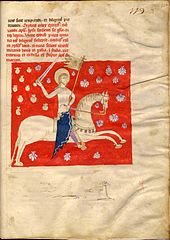Santiago de Compostela
Santiago de Compostela has a very mild climate for its latitude with heavy winter rainfall courtesy of its relative proximity to the prevailing winds from Atlantic low-pressure systems.Eight hundred years later the light of a bright star guided a shepherd, Pelagius the Hermit, who was watching his flock at night to the burial site in Santiago de Compostela.[6] This site was originally called Mount Libredon [gl] and its physical topography leads prevalent seaborne winds to clear the cloud deck immediately overhead.The legend, which included numerous miraculous events, enabled the Catholic faithful to bolster support for their stronghold in northern Spain during the Christian crusades against the Moors, but also led to the growth and development of the city.The winters are mild, despite being far inland and at an altitude of 370 metres (1,210 ft) frosts are only common in December, January and February, with an average of just 13 days per year.[19][20][21] At some point between 818 and 842,[22] during the reign of Alfonso II of Asturias,[23][24] bishop Theodemar of Iria (d. 847) claimed to have found some remains which were attributed to Saint James the Greater.This discovery was accepted in part because Pope Leo III[25] and Charlemagne—who had died in 814—had acknowledged Asturias as a kingdom and Alfonso II as king, and had also crafted close political and ecclesiastic ties.[28] After the centre of Asturian political power moved from Oviedo to León in 910, Compostela became more politically relevant, and several kings of Galicia and of León were acclaimed by the Galician noblemen and crowned and anointed by the local bishop at the cathedral, among them Ordoño IV in 958,[29] Bermudo II in 982, and Alfonso VII in 1111, by which time Compostela had become capital of the Kingdom of Galicia.In 997 Compostela was assaulted and partially destroyed by Ibn Abi Aamir (known as al-Mansur), Andalusian leader accompanied in his raid by Christian lords, who all received a share of the booty.[32][33].Santiago de Compostela was captured and sacked by the French during the Napoleonic Wars; as a result, the remains attributed to the apostle were lost for near a century, hidden inside a cist in the crypts of the cathedral of the city.[35] Santiago's economy, although still heavily dependent on public administration (i.e. being the headquarters of the autonomous government of Galicia), cultural tourism, industry, and higher education through its university, is becoming increasingly diversified.Following the Xunta's considerable investment and hugely successful advertising campaign for the Holy Year of 1993, the number of pilgrims completing the route has been steadily rising.During medieval times, the Santiago de Compostela pilgrimage emerged as one of the most significant Christian journeys in Europe, attracting thousands of pilgrims seeking spiritual redemption and fulfillment.[40] This sacred journey leads to the Cathedral of Santiago de Compostela in the Galicia region of northwest Spain, where the remains of Saint James the Apostle are believed to be buried.[42] The legend that St. James found his way to the Iberian Peninsula and had preached there is one of a number of early traditions concerning the missionary activities and final resting places of the apostles of Jesus.According to a tradition that can be traced back at least to the 12th century, when it was recorded in the Codex Calixtinus, Saint James decided to return to the Holy Land after preaching in Galicia.Santiago de Compostela is featured prominently in the 1988 historical fiction novel Sharpe's Rifles, by Bernard Cornwell, which takes place during the French Invasion of Galicia, January 1809, during the Napoleonic Wars.A pilgrimage to Santiago de Compostela provides the narrative framework of the Luis Buñuel film La Voie lactée (The Milky Way).













MunicipalityCathedralHostal dos Reis CatólicosSan Martiño PinarioPazo de RaxoiCoat of armsAutonomous CommunityGaliciaProvinceA CoruñaParishesMayor–councilDemonymsTime zoneArea codeSaint James the GreatCathedral of Santiago de CompostelaWay of St. JamespilgrimageUNESCO World Heritage SiteAtlanticlow-pressure systemsVulgar LatinJames, son of ZebedeePelagius the HermitLibredonTheodemirOviedolegendCatholic MonarchsIsabella of CastilleFerdinand II of AragonParadorSpanish euro coinsUniversity of Santiago de CompostelaGalicianSpanishSantiagoCalatravaAlcántaraMontesaAssociation for Equal and Fair Trade PangaeaKöppen climate classificationoceanic climateAgencia Estatal de MeteorologíaSantiago de Compostela Airportm.a.s.l.relative humiditysunshine hoursSantiago de Compostela (Old Town)Sessionmayor–council form of government2023 Spanish local electionsCompostela AbertaPeople's PartySocialists' Party of GaliciaSpanish Socialist Workers' PartyGalician Nationalist BlocCitizensCommitment to GaliciaConverxencia XXINational Statistics InstituteBraziliansPortugueseColombiansXunta de Galiciamother tongueRomanesqueFerdinand IIcollapse of the Roman EmpirebishopricIria FlaviaTheodemarSuebi KingdomLeovigildVisigothic KingdomKingdom of AsturiasAlfonso II of AsturiasTheodemar of IriaSaint James the GreaterPope Leo IIICharlemagneUsuardSaint EulaliaSaint Aemiliankings of Galiciaof LeónOrdoño IVBermudo IIAlfonso VIIKingdom of GaliciaFernando IIAlfonso IXKingdom of CastileVikingIbn Abi AamirCresconioJerusalemDiego GelmírezprelateBérenger de LandoreNapoleonic WarscryptsmartyriumPriscillianuniversityUROVESANovacaixagaliciaFeast of Saint JamesTelevisión de Galiciapublic broadcasterCodex CalixtinusIberian PeninsulaPope Leo XIIIVaticanSt JamesSantiago de Compostela CathedralBrian SewellThe Naked PilgrimChannel 5Martin SheenEmilio EstevezThe WayHoly Landstone shipdragon


